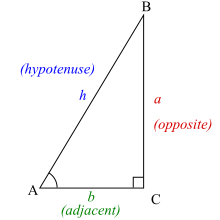Proof
There are several equivalent ways for defining trigonometric functions, and the proof of the trigonometric identities between them depend on the chosen definition. The oldest and somehow the most simple definition is based on the geometry of right triangles. The proofs given in this commodity use this definition, and thus apply to not-negative angles not greater than a right angle. For greater and negative angles, see Trigonometric functions.
Other definitions, and therefore other proofs are based on the Taylor serial of sine and cosine, or on the differential equation  to which they are solutions.
to which they are solutions.
Uncomplicated trigonometric identities [edit]
Definitions [edit]

Trigonometric functions specify the relationships between side lengths and interior angles of a correct triangle. For example, the sine of angle θ is defined as existence the length of the opposite side divided past the length of the hypotenuse.
The six trigonometric functions are defined for every real number, except, for some of them, for angles that differ from 0 by a multiple of the right angle (ninety°). Referring to the diagram at the right, the half-dozen trigonometric functions of θ are, for angles smaller than the right bending:
-

-

-

-

-

-

Ratio identities [edit]
In the case of angles smaller than a right angle, the following identities are direct consequences of above definitions through the division identity
-

They remain valid for angles greater than 90° and for negative angles.
-

-

-

-

-

Or
-

-

Complementary angle identities [edit]
Two angles whose sum is π/2 radians (90 degrees) are complementary. In the diagram, the angles at vertices A and B are complementary, and then we tin can exchange a and b, and change θ to π/2 − θ, obtaining:
-

-

-

-

-

-

Pythagorean identities [edit]
Identity 1:
-

The post-obit two results follow from this and the ratio identities. To obtain the first, divide both sides of  past
past  ; for the 2d, divide by
; for the 2d, divide by  .
.
-

-

Similarly
-

-

Identity two:
The following accounts for all three reciprocal functions.
-

Proof 2:
Refer to the triangle diagram above. Note that  by Pythagorean theorem.
by Pythagorean theorem.
-

Substituting with appropriate functions -
-

Rearranging gives:
-

Angle sum identities [edit]
Sine [edit]

Analogy of the sum formula.
Depict a horizontal line (the ten-axis); mark an origin O. Draw a line from O at an angle  above the horizontal line and a second line at an angle
above the horizontal line and a second line at an angle  to a higher place that; the bending between the 2d line and the ten-centrality is
to a higher place that; the bending between the 2d line and the ten-centrality is  .
.
Identify P on the line defined past  at a unit distance from the origin.
at a unit distance from the origin.
Allow PQ be a line perpendicular to line OQ divers by angle  , fatigued from point Q on this line to betoken P.
, fatigued from point Q on this line to betoken P.  OQP is a right angle.
OQP is a right angle.
Let QA be a perpendicular from point A on the 10-axis to Q and Lead be a perpendicular from point B on the 10-axis to P.  OAQ and OBP are correct angles.
OAQ and OBP are correct angles.
Draw R on PB and then that QR is parallel to the 10-axis.
At present angle  (because
(because  , making
, making  , and finally
, and finally  )
)
-

-

-

-

-
 , so
, so 
-
 , so
, so 
-

By substituting  for
for  and using Symmetry, we as well get:
and using Symmetry, we as well get:
-

-

Cosine [edit]
Using the figure above,
-

-

-

-
 , so
, so 
-
 , so
, so 
-

By substituting  for
for  and using Symmetry, we also get:
and using Symmetry, we also get:
-

-

Also, using the complementary angle formulae,
-

Tangent and cotangent [edit]
From the sine and cosine formulae, nosotros get
-

Dividing both numerator and denominator past  , nosotros get
, nosotros get
-

Subtracting  from
from  , using
, using  ,
,
-

Similarly from the sine and cosine formulae, we go
-

Then by dividing both numerator and denominator past  , we become
, we become
-

Or, using  ,
,
-

Using  ,
,
-

Double-angle identities [edit]
From the angle sum identities, we get
-

and
-

The Pythagorean identities give the two alternative forms for the latter of these:
-

-

The bending sum identities also requite
-

-

It tin also be proved using Euler's formula
-

Squaring both sides yields
-

Merely replacing the angle with its doubled version, which achieves the aforementioned issue in the left side of the equation, yields
-

It follows that
-
 .
.
Expanding the foursquare and simplifying on the left hand side of the equation gives
-
 .
.
Because the imaginary and real parts accept to be the same, we are left with the original identities
-
 ,
,
and also
-
 .
.
One-half-bending identities [edit]
The two identities giving the alternative forms for cos 2θ atomic number 82 to the post-obit equations:
-

-

The sign of the square root needs to exist called properly—note that if iiπ is added to θ, the quantities inside the square roots are unchanged, just the left-hand-sides of the equations change sign. Therefore, the correct sign to use depends on the value of θ.
For the tan part, the equation is:
-

Then multiplying the numerator and denominator within the square root past (i + cos θ) and using Pythagorean identities leads to:
-

Also, if the numerator and denominator are both multiplied by (1 - cos θ), the result is:
-

This also gives:
-

Like manipulations for the cot part give:
-

Miscellaneous – the triple tangent identity [edit]
If  half circumvolve (for example,
half circumvolve (for example,  ,
,  and
and  are the angles of a triangle),
are the angles of a triangle),
-

Proof:[1]
-

Miscellaneous – the triple cotangent identity [edit]
If  quarter circle,
quarter circle,
-
 .
.
Proof:
Replace each of  ,
,  , and
, and  with their complementary angles, so cotangents turn into tangents and vice versa.
with their complementary angles, so cotangents turn into tangents and vice versa.
Given
-

-

and so the issue follows from the triple tangent identity.
Sum to product identities [edit]
Proof of sine identities [edit]
First, start with the sum-angle identities:
-

-

By adding these together,
-

Similarly, by subtracting the two sum-bending identities,
-

Let  and
and  ,
,
-
 and
and 
Substitute  and
and 
-

-

Therefore,
-

Proof of cosine identities [edit]
Similarly for cosine, start with the sum-angle identities:
-

-

Again, by adding and subtracting
-

-

Substitute  and
and  as before,
as before,
-

-

Inequalities [edit]

Illustration of the sine and tangent inequalities.
The figure at the correct shows a sector of a circle with radius 1. The sector is θ/(2π) of the whole circle, so its expanse is θ/two. We presume here that θ < π/2.
-

-

-

The expanse of triangle OAD is AB/2, or sin(θ)/ii. The surface area of triangle OCD is CD/ii, or tan(θ)/two.
Since triangle OAD lies completely inside the sector, which in plow lies completely within triangle OCD , we have
-

This geometric argument relies on definitions of arc length and area, which act every bit assumptions, and then it is rather a condition imposed in construction of trigonometric functions than a provable belongings.[two] For the sine function, we can handle other values. If θ > π/2, so θ > 1. Merely sin θ ≤ ane (considering of the Pythagorean identity), so sin θ < θ . And so nosotros have
-

For negative values of θ we have, by the symmetry of the sine function
-

Hence
-

and
-

Identities involving calculus [edit]
Preliminaries [edit]
-

-

Sine and angle ratio identity [edit]
-

In other words, the function sine is differentiable at 0, and its derivative is 1.
Proof: From the previous inequalities, we have, for small angles
-
 ,
,
Therefore,
-
 ,
,
Consider the right-hand inequality. Since
-

-

Multiply through by 
-

Combining with the left-mitt inequality:
-

Taking  to the limit as
to the limit as 
-

Therefore,
-

Cosine and angle ratio identity [edit]
-

Proof:
-

The limits of those three quantities are one, 0, and 1/2, so the resultant limit is zero.
Cosine and foursquare of bending ratio identity [edit]
-

Proof:
As in the preceding proof,
-

The limits of those three quantities are 1, i, and one/ii, and then the resultant limit is 1/2.
Proof of compositions of trig and inverse trig functions [edit]
All these functions follow from the Pythagorean trigonometric identity. We can testify for case the function
-
![\sin[\arctan(x)]=\frac{x}{\sqrt{1+x^2}}](https://wikimedia.org/api/rest_v1/media/math/render/svg/7d3ed8cedb4c73b01b65314a15152647c9000086)
Proof:
We outset from
-
 (I)
(I)
And so we dissever this equation (I) by 
-
 (2)
(2) -

And then use the commutation  :
:
-
![1-\sin ^{2}[\arctan(x)]={\frac {1}{\tan ^{2}[\arctan(x)]+1}}](https://wikimedia.org/api/rest_v1/media/math/render/svg/d0bb45d076e27715801c0437e364d4b1f45dfb1a)
-
![{\displaystyle \sin ^{2}[\arctan(x)]={\frac {\tan ^{2}[\arctan(x)]}{\tan ^{2}[\arctan(x)]+1}}}](https://wikimedia.org/api/rest_v1/media/math/render/svg/31457873262613ebf792de2499d564919e4d18c9)
Then we use the identity ![\tan[\arctan(x)]\equiv x](https://wikimedia.org/api/rest_v1/media/math/render/svg/49ce3dc146ff12eb2efb89a4388afcb984b7da8e)
-
![\sin[\arctan(x)]={\frac {x}{{\sqrt {x^{2}+1}}}}](https://wikimedia.org/api/rest_v1/media/math/render/svg/5c5222bb21dc2d342d1363c855694bae8b967914) (III)
(III)
And initial Pythagorean trigonometric identity proofed...
Similarly if we divide this equation (I) by 
-
 (Two)
(Two) -

So use the substitution  :
:
-
![{\displaystyle \sin ^{2}[\arctan(x)]={\frac {\tan ^{2}[\arctan(x)]}{\tan ^{2}[\arctan(x)]+1}}}](https://wikimedia.org/api/rest_v1/media/math/render/svg/31457873262613ebf792de2499d564919e4d18c9)
Then nosotros utilize the identity ![\tan[\arctan(x)]\equiv x](https://wikimedia.org/api/rest_v1/media/math/render/svg/49ce3dc146ff12eb2efb89a4388afcb984b7da8e)
-
![\sin[\arctan(x)]={\frac {x}{{\sqrt {x^{2}+1}}}}](https://wikimedia.org/api/rest_v1/media/math/render/svg/5c5222bb21dc2d342d1363c855694bae8b967914) (III)
(III)
And initial Pythagorean trigonometric identity proofed...
-
![{\displaystyle [\arctan(x)]=[\arcsin({\frac {x}{\sqrt {x^{2}+1}}})]}](https://wikimedia.org/api/rest_v1/media/math/render/svg/dbc17437ca395ab8ec9e04f2d21096288df5b9a2)
-

-
 (Iv)
(Iv)
Let we approximate that we accept to prove:
-

-
 (5)
(5)
Replacing (V) into (IV) :
-

-

So it's truthful:  and guessing argument was true:
and guessing argument was true: 
-
![{\displaystyle [\arctan(x)]=[\arcsin({\frac {x}{\sqrt {x^{2}+1}}})]=[\arcsin(y)]=[\arctan({\frac {y}{\sqrt {1-y^{2}}}})]}](https://wikimedia.org/api/rest_v1/media/math/render/svg/7fbaafc98c5960a737537039cff02fdd72be65da)
Now y can be written equally x ; and we accept [arcsin] expressed through [arctan]...
-
![{\displaystyle [\arcsin(x)]=[\arctan({\frac {x}{\sqrt {1-x^{2}}}})]}](https://wikimedia.org/api/rest_v1/media/math/render/svg/552a4ab628e13245dc277ab57029427f50ee8ebd)
Similarly if we seek : ![{\displaystyle [\arccos(x)]}](https://wikimedia.org/api/rest_v1/media/math/render/svg/4f61004b1d4ad7ff39f9a7ee50976ec672d2c198) ...
...
-
![{\displaystyle \cos[\arccos(x)]=x}](https://wikimedia.org/api/rest_v1/media/math/render/svg/d9d5691af1ed2de3248e08dbaf90a24a80c1c816)
-
![{\displaystyle \cos({\frac {\pi }{2}}-({\frac {\pi }{2}}-[\arccos(x)]))=x}](https://wikimedia.org/api/rest_v1/media/math/render/svg/7562bfeec9737b56e7affe3409239315302693c3)
-
![{\displaystyle \sin({\frac {\pi }{2}}-[\arccos(x)])=x}](https://wikimedia.org/api/rest_v1/media/math/render/svg/5ad20b817a17336b1fc1af8c339a3d7e4cf111f6)
-
![{\displaystyle {\frac {\pi }{2}}-[\arccos(x)]=[\arcsin(x)]}](https://wikimedia.org/api/rest_v1/media/math/render/svg/20f54833eb7dbe561e4cb31e51453ebd14a5cc51)
-
![{\displaystyle [\arccos(x)]={\frac {\pi }{2}}-[\arcsin(x)]}](https://wikimedia.org/api/rest_v1/media/math/render/svg/dfc6a970c74fe335d2b0684f23027e6ca255a9cc)
From : ![{\displaystyle [\arcsin(x)]}](https://wikimedia.org/api/rest_v1/media/math/render/svg/ef6f2837ad8f82968478d6c5e93863549f833207) ...
...
-
![{\displaystyle [\arccos(x)]={\frac {\pi }{2}}-[\arctan({\frac {x}{\sqrt {1-x^{2}}}})]}](https://wikimedia.org/api/rest_v1/media/math/render/svg/e6675d621ebaf7c4c4b10adbee9a1fd4b6f1d6eb)
-
![{\displaystyle [\arccos(x)]={\frac {\pi }{2}}-[\operatorname {arccot}({\frac {\sqrt {1-x^{2}}}{x}})]}](https://wikimedia.org/api/rest_v1/media/math/render/svg/a4fe5f411d564cd54abb12c188ca5885150f1949)
And finally we have [arccos] expressed through [arctan]...
-
![{\displaystyle [\arccos(x)]=[\arctan({\frac {\sqrt {1-x^{2}}}{x}})]}](https://wikimedia.org/api/rest_v1/media/math/render/svg/13428b7bd426702f18227deb2d8da5f116c16db4)
Run across besides [edit]
- List of trigonometric identities
- Bhaskara I'due south sine approximation formula
- Generating trigonometric tables
- Aryabhata'south sine tabular array
- Madhava'southward sine table
- Tabular array of Newtonian series
- Madhava series
- Unit vector (explains direction cosines)
- Euler's formula
Notes [edit]
- ^ "Tangent Identity | Math 老师". Archived from the original on 2013-10-29. Retrieved 2013-10-xxx . expressionless link
- ^ Richman, Fred (March 1993). "A Round Statement". The College Mathematics Journal. 24 (2): 160–162. doi:x.2307/2686787. JSTOR 2686787.
References [edit]
- Due east. T. Whittaker and G. N. Watson. A Class of Modernistic Analysis, Cambridge University Printing, 1952















































































































































![\sin[\arctan(x)]=\frac{x}{\sqrt{1+x^2}}](https://wikimedia.org/api/rest_v1/media/math/render/svg/7d3ed8cedb4c73b01b65314a15152647c9000086)



![1-\sin ^{2}[\arctan(x)]={\frac {1}{\tan ^{2}[\arctan(x)]+1}}](https://wikimedia.org/api/rest_v1/media/math/render/svg/d0bb45d076e27715801c0437e364d4b1f45dfb1a)
![{\displaystyle \sin ^{2}[\arctan(x)]={\frac {\tan ^{2}[\arctan(x)]}{\tan ^{2}[\arctan(x)]+1}}}](https://wikimedia.org/api/rest_v1/media/math/render/svg/31457873262613ebf792de2499d564919e4d18c9)
![\tan[\arctan(x)]\equiv x](https://wikimedia.org/api/rest_v1/media/math/render/svg/49ce3dc146ff12eb2efb89a4388afcb984b7da8e)
![\sin[\arctan(x)]={\frac {x}{{\sqrt {x^{2}+1}}}}](https://wikimedia.org/api/rest_v1/media/math/render/svg/5c5222bb21dc2d342d1363c855694bae8b967914)


![{\displaystyle [\arctan(x)]=[\arcsin({\frac {x}{\sqrt {x^{2}+1}}})]}](https://wikimedia.org/api/rest_v1/media/math/render/svg/dbc17437ca395ab8ec9e04f2d21096288df5b9a2)







![{\displaystyle [\arctan(x)]=[\arcsin({\frac {x}{\sqrt {x^{2}+1}}})]=[\arcsin(y)]=[\arctan({\frac {y}{\sqrt {1-y^{2}}}})]}](https://wikimedia.org/api/rest_v1/media/math/render/svg/7fbaafc98c5960a737537039cff02fdd72be65da)
![{\displaystyle [\arcsin(x)]=[\arctan({\frac {x}{\sqrt {1-x^{2}}}})]}](https://wikimedia.org/api/rest_v1/media/math/render/svg/552a4ab628e13245dc277ab57029427f50ee8ebd)
![{\displaystyle [\arccos(x)]}](https://wikimedia.org/api/rest_v1/media/math/render/svg/4f61004b1d4ad7ff39f9a7ee50976ec672d2c198)
![{\displaystyle \cos[\arccos(x)]=x}](https://wikimedia.org/api/rest_v1/media/math/render/svg/d9d5691af1ed2de3248e08dbaf90a24a80c1c816)
![{\displaystyle \cos({\frac {\pi }{2}}-({\frac {\pi }{2}}-[\arccos(x)]))=x}](https://wikimedia.org/api/rest_v1/media/math/render/svg/7562bfeec9737b56e7affe3409239315302693c3)
![{\displaystyle \sin({\frac {\pi }{2}}-[\arccos(x)])=x}](https://wikimedia.org/api/rest_v1/media/math/render/svg/5ad20b817a17336b1fc1af8c339a3d7e4cf111f6)
![{\displaystyle {\frac {\pi }{2}}-[\arccos(x)]=[\arcsin(x)]}](https://wikimedia.org/api/rest_v1/media/math/render/svg/20f54833eb7dbe561e4cb31e51453ebd14a5cc51)
![{\displaystyle [\arccos(x)]={\frac {\pi }{2}}-[\arcsin(x)]}](https://wikimedia.org/api/rest_v1/media/math/render/svg/dfc6a970c74fe335d2b0684f23027e6ca255a9cc)
![{\displaystyle [\arcsin(x)]}](https://wikimedia.org/api/rest_v1/media/math/render/svg/ef6f2837ad8f82968478d6c5e93863549f833207)
![{\displaystyle [\arccos(x)]={\frac {\pi }{2}}-[\arctan({\frac {x}{\sqrt {1-x^{2}}}})]}](https://wikimedia.org/api/rest_v1/media/math/render/svg/e6675d621ebaf7c4c4b10adbee9a1fd4b6f1d6eb)
![{\displaystyle [\arccos(x)]={\frac {\pi }{2}}-[\operatorname {arccot}({\frac {\sqrt {1-x^{2}}}{x}})]}](https://wikimedia.org/api/rest_v1/media/math/render/svg/a4fe5f411d564cd54abb12c188ca5885150f1949)
![{\displaystyle [\arccos(x)]=[\arctan({\frac {\sqrt {1-x^{2}}}{x}})]}](https://wikimedia.org/api/rest_v1/media/math/render/svg/13428b7bd426702f18227deb2d8da5f116c16db4)






0 Response to "What Is The Pythagorean Identity"
Post a Comment